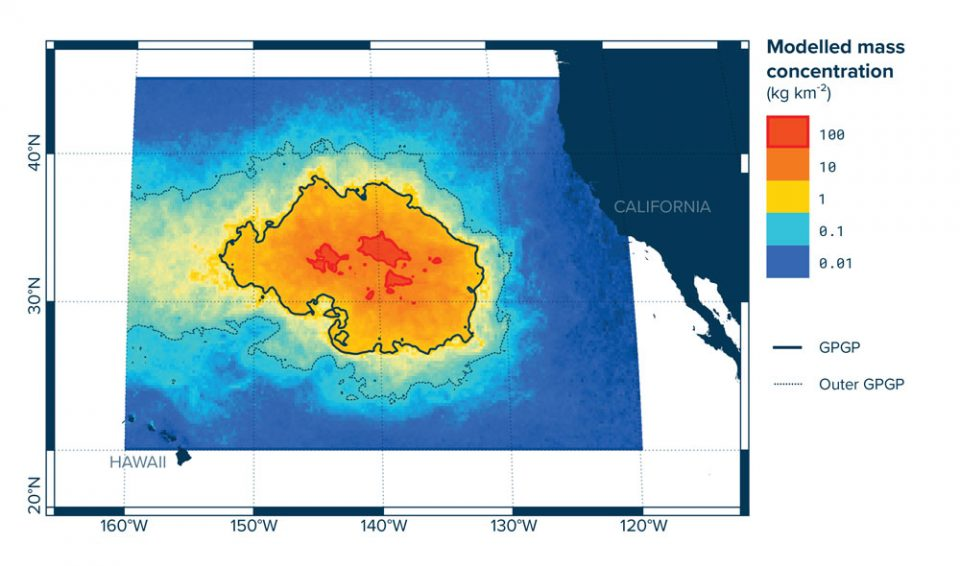Garbage ‘patches’: A buoyant Dumpster-fire
Amber Abbas. 07/03/2021

Right now, as you read this, a 1.6 million-square-kilometer expanse of trash is sailing in the Pacific Ocean, off the coast of Hawai’i. The word ‘patch’ is a misnomer; that immense stretch of filth sailing amongst the thunderous waves of the Pacific Ocean isn’t a ‘patch’ in any sense of the word. It’s a collection of 1.8 trillion pieces of plastic – 250 for every human being alive, weighing about 80,000 tonnes. That’s about as heavy as 250 jumbo jets and spread over an area three times the size of France. This garbage, orbiting around 32°N and 145°W, is the world’s largest collection of ocean debris. Let’s dive deeper and learn more about the GPGP.
These metric tonnes of garbage weren’t in the ocean since time immemorial. We humans are solely responsible for this nasty turn of events. Plastic items thrown in the ocean catch the flow of water currents, sail across thousands of kilometers, and end up in the patch. The area in the center of a gyre tends to be very calm and stable. Additionally, the circular motion of the gyre draws debris into this center, where it gets trapped for what seems like an eternity.
Distribution of the debris

The garbage within the patch is densely distributed but does not form a solid mass. There is no island of trash. Instead, it ranges from light, floatable plastics at the periphery to debris so big it touches the ocean floor. The center of the patch has more than 100kg/m2 of debris while there’s only 10kg/m2 on the boundary.
Plastic, which makes the entirety of the debris, does not decompose. Over the years, larger pieces just break into smaller fragments called microplastics. This deterioration into microplastics is usually the result of sun exposure, waves, marine life, and temperature changes. Microplastics have been discovered floating within the water surface layers, in the water column, and as far down as the ocean floor. These microplastics account for 94% of the floating pieces and simply do not go away. They are a hazard to aquatic animals, both small and large. They’re also very difficult to pull out of the ocean, being almost invisible from vessels due to their minuscule size ranging from 0.05 to 0.5 centimeters.
Dangers arising from the trash/patch
Apart from reflecting the effect that humankind has had on the Earth, the debris is a serious threat to aquatic life. Fishing nets, which make up about 45% of all the garbage, floating in the debris lead to ‘ghost fishing’, meaning aquatic animals constantly becoming tangled in the nets without anyone at the helm. An estimated 100,000 marine animals are strangled, suffocated, or injured by plastics every year. The sheer amount of trash may even destabilize the fragile ocean ecosystem, impacting seafood and people who eat it.
So, what can we do about the GPGP?
At the moment, scientists believe that there is no practical way to clean the patch. Charles Moore, the man who discovered the patch, said that cleaning up the patch could “bankrupt entire nations”. The National Ocean and Atmospheric Administration’s (NOAA) Marine Debris Program has estimated that it would take 67 ships a year to clean up less than one percent of the North Pacific Ocean. The area of the North Pacific is 77,010,000 km2. Needless to say, the current population will be long gone before the patch has been cleaned. It is a collection of garbage brought in by rivers from multiple countries into the ocean, a mishmash of waste ranging from plastic crates manufactured in the ‘70s to hard hats made in 2010, a multitude of filth, and a timeless reminder that humans do not deserve good things.
The trash already in the ocean is here to stay for the foreseeable future. We cannot do anything to dispose of it. What we can do though, is never, ever, dump trash in the ocean. The Earth’s waters cannot and should not handle people’s waste. It is high time for us to stop treating the Earth as our dumping ground, taking the ravines and plains for granted, for us to stop being nasty.For, as the present situation has demonstrated, when worse comes to worst, even the most powerful find it difficult to catch a breath.
Cover Photo: (The Ocean cleanup)
